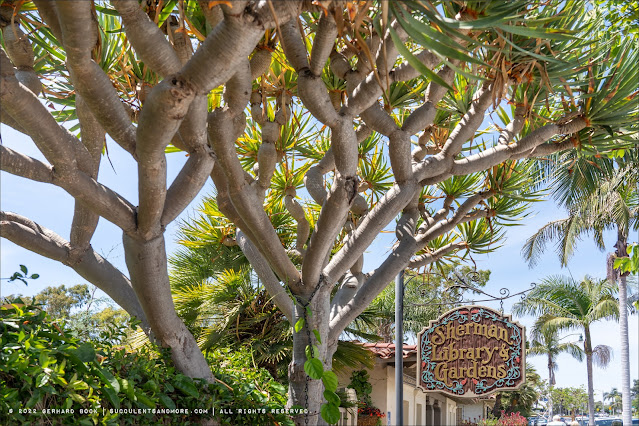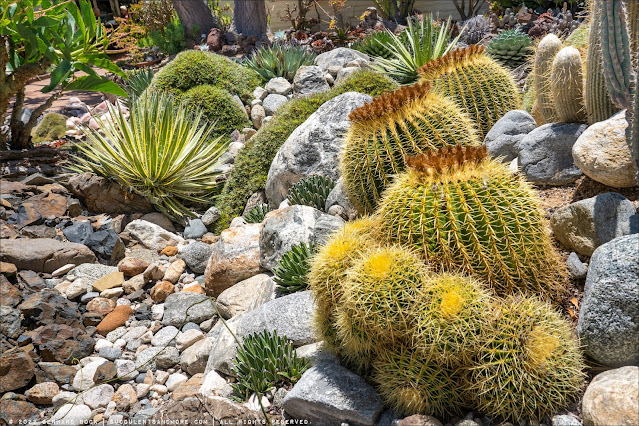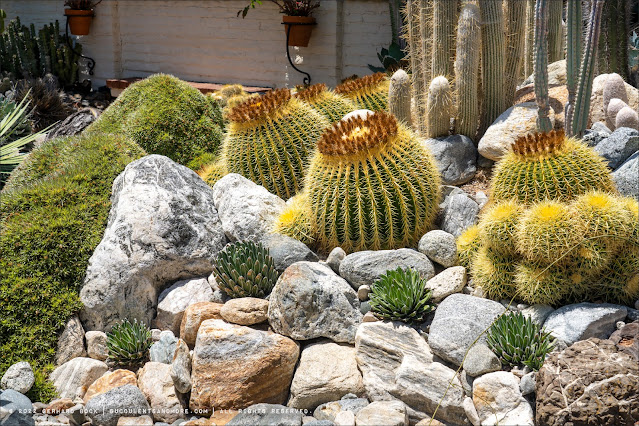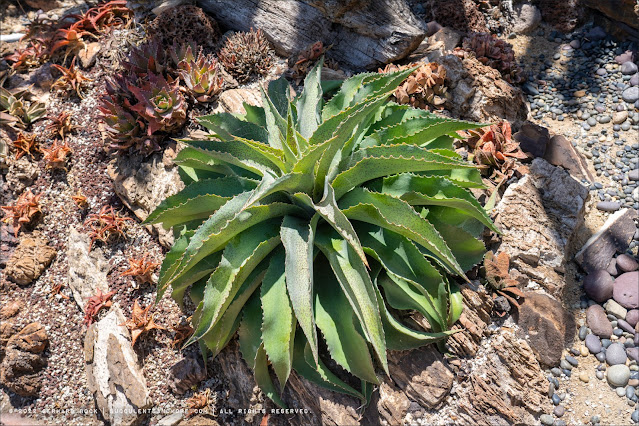Sherman Library & Gardens may be on the small side, at least as far as public gardens go. But its location—right on the Pacific Coast Highway, less than a mile from the Pacific Ocean—and the Goldilocks climate that comes with it cannot be beat.
Sherman Library & Gardens is the brainchild of businessman Arnold Haskell (1895-1977). Auspiciously enough, when Haskell bought the core property in 1955, it was a plant nursery. The old adobe house at the corner of Dahlia Ave and Coast Highway, now part of the Library, was built in the late 1930s by the Lushbaughs, a young couple who hand-fired all the adobe bricks. They had bought the land from the City of Newport Beach for $600—less than the price of a square foot of an average property today!
It’s hard to imagine now, but before World War II, few people wanted to buy land in Corona del Mar. Why? Initially, the railroad ended at the Balboa Peninsula, a mile to the north (see map at the bottom of this post), making access inconvenient. Even the opening of the Coast Highway in 1926 didn’t result in a boom. Then the Great Depression hit, putting a damper on economic development for ten years (1929-1939). It wasn’t until after WWII that real estate in coastal southern California began its meteoric rise.
But back to Arnold Haskell. In the 1960s, he acquired the remaining lots of the 2.2 acre block and created a series of gardens open to the public as a refuge from the “stress and pressures of daily schedules” (1). He chose the name Sherman Library & Gardens to honor his mentor and benefactor Moses Hazeltine Sherman (1853-1932), a pioneering Southern California real-estate developer (the Los Angeles neighborhood of Sherman Oaks still carries his name). So in spite of its important-sounding moniker suggesting roots going back to the early days of California, Sherman Library & Gardens has a much more down-to-earth history, starting with what had been Norman’s Nursery and the Lushbaughs’ 1930’s single-room adobe house. Whereas the Huntington, for instance, began as a lavish private estate before it evolved into what it is today, Sherman Library & Gardens was always meant to be a place for the public.
While this post focuses on the gardens, I should add that Sherman Library holds more than 15,000 volumes documenting the development of the Pacific Southwest—southern California, Arizona, and northern Mexico—as well as California Impressionist art.
 |
| Magnificent dragon trees (Dracaena draco)... |
 |
| ...line the sidewalk outside Sherman Library & Gardens |
 |
| View across the street |
The gardens are a series of distinct areas, each with a different plant or design focus. There’s the Sun Garden (annuals and perennials reminiscent of a cottage garden), Formal Garden (hedges and herbs in interlocking knots), Bromeliad Garden, Tropical Conservatory, Mediterranean Climate Garden, Fern Grotto, Perennial Garden, Palm Collection, Succulent Garden, Tea Garden (a patio garden with fuchsias, begonias, and impatiens), and Specimen Shade Garden (tropicals hardy enough to grow outside in a lathe house). I typically wander through the entire garden—which doesn’t take long, considering it’s only two acres—but invariably I spend the bulk of my time in the Succulent Garden.
Here’s a selection of photos from my most recent visit in July 2022, starting with the Bromeliad Garden:
 |
| Very few plants are labeled, so I don’t know the names of these Neoregelia hybrids, but they sure are spectacular |
 |
| Vrieseas |
 |
| Tillandsias attached to a stucco wall |
 |
More neoregelias
|
 |
| Burgundy-colored neoregalias underplanted with coleus (?) |
 |
| Kudos to the gardeners. They make it all possible. |
 |
| Leucadendron ‘Safari Jester’, with the café in the background |
 |
| Plantings between the Tropical Conservatory and the Specimen Shade Garden |
 |
| Rat with bushy tail, aka squirrel, next to a dragon tree |
 |
| If this were my personal garden... |
 |
| ...I would be very, very happy |
 |
| Tillandsias wired to the trunk of a palm |
 |
| Formal Garden |
 |
Always a treat to see bananas
|
Now we’re in the Succulent Garden. As I mentioned, this is where I typically spend the bulk of my time. It was no different on this visit.
 |
| Muted color palette, yet so much variety |
 |
| Dudleyas, echeverias, billbergias, neoregelias, tillandsias, and a Senecio crassissimus as an upright shrubby element |
 | | Iconic backdrop of Aloidendron barberae, Euphorbia ammak ‘Variegata’, and Euphorbia ingens |
 | | The central bed of the Succulent Garden |
 | | Cactus playground |
|
 |
| Golden barrels (Echinocactus grusonii) |
 |
| Variegated Agave schidigera, mat-forming Deuterocohnia brevifolia, and Agave victoriae-reginae |
 |
| Wider view |
 |
This ponytail palm (Beaucarnea recurvata) must have come close to death at some point and then sprung back to life
|
 |
| Euphorbia cooperi |
 |
| Dudleya brittonii |
In a 2010 article in Pacific Horticulture Magazine entitled “A Succulent Oasis at Sherman Library & Gardens" (
here), Matt describes the project in great detail: “To foster public appreciation of a xeric garden, we amplified the soft whispers of desert beauty. The concept was to concentrate 1,200 square miles of desert splendor into 1,200 square feet, erasing any empty voids between points of interest. Every square inch was carpeted with detail—no barren soil left at all.”
He continues: “Molding succulents into a metaphor of water was no accident; I wanted a garden so packed with latent moisture that it could be deemed a water garden. To counteract widely held misconceptions about xeric plants, we used the dwarf blue senecios to represent a river, with ‘water’ cascading into it from a massive terra cotta basin. If such opulence did not suggest a succulent oasis (rather than fabricated images of desolation), all hope would be lost amidst the swirling desert sands.”
I highly recommend you read Matt’s
Pacific Horticulture article. It sheds light not only on the design process but also on the history of Sherman Library & Gardens.
It’s hard to do the Succulent Mosaic justice. There are so many details, I could have spent hours analyzing everything. Considering that plants like echeverias and sedums are vigorous growers, maintaining this bed in the perfect condition I found it in must be time-consuming. I, for one, appreciate the effort put in by the staff and volunteers to keep things looking pristine.
One last look at the Desert Garden:
Adjacent to the Succulent Garden is a massive Peruvian pepper tree (Schinus molle) planted in the early 1940s by the Lushbaughs after they had completed their one-room adobe house. The tree is now almost 80 years old.
 |
| Peruvian pepper tree (Schinus molle) |
Finally, a couple of maps to help you get your bearing:
 |
| Los Angeles and Orange Counties, with Corona del Mar indicated by the green arrow |
 |
| Locations in the Newport Beach area I’ve blogged about before |
Balboa Island:Roger’s Gardens:
Newport Beach Civic Center:
Inspiration Point in Corona del Mar:
Sherman Library & Gardens:
© Gerhard Bock, 2022. All rights reserved. To receive all new posts by email, please subscribe here.





















































I never get tired of seeing photos from the Sherman gardens: the central cacti bed, the succulent mosaic (of course), and "Tillandsias on a trunk". My favorite photo today though is the 80 year old Peruvian pepper tree: "One last look at the Desert Garden". It's awesome.
ReplyDeletechavli
I'm with you, that pepper tree is pretty amazing. It fills the entire courtyard in front of the small adobe.
DeleteI still haven't managed to visit this little paradise. Someday!
ReplyDeleteLet's meet there the next time you're in the L.A. area!
DeleteI'm glad you finally got there, Gerhard! Even though it's small, I'd long suspected you'd enjoy it - it's like a jewel box, and as many plants are changed out seasonally, there's always something new to see. I usually visit at least 3 times a year. Kudos for mentioning the work of the volunteers too, as they're a big factor in its continuously pristine appearance. My friend, Kay, who like me was formerly a docent at our nearby botanic garden, is an active volunteer there now.
ReplyDeleteYes!! The Sherman's size is much easier to relate to than, say, the Huntington's. Maybe we can have a mini reunion at the Sherman the next time I'm in the OC!
DeleteHi Gerhard! I’m so pleased that Kris directed me to your blog post. I haven’t been active on IG, but I remain an active supporter and volunteer of Sherman Library and Gardens. Gardening is one of my favorite volunteer activities there and it is amazing the variety of plants on this 2.2 acre property. The horticultural team are top-notch designers and horticultural experts and are simply a joy to work with! I wish I could have given you a personal tour. Did you see all the xMangaves? Kay aka Kaeru Niwa
ReplyDeleteKay, next time I'd love to meet you at the Sherman for a tour. Yes, I noticed the mangaves; it's great to see them find their way into so many gardens, private and public.
Delete